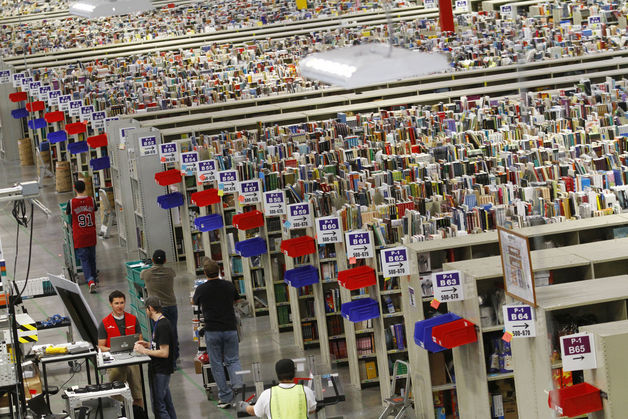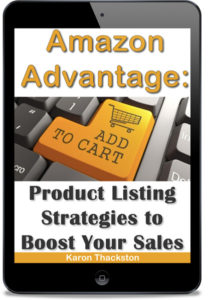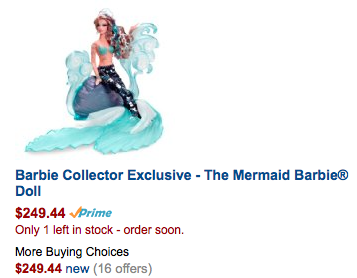If you’ve been selling on Amazon at least 6 months, then it’s possible you will receive a FBA Aged Inventory Notification email from Amazon. Twice a year, (February 15th and August 15th), Amazon charges a long-term storage fee for all items that have been stored in a FBA warehouse for 6 months or longer.
UPDATE: Starting September 15 of 2018, Amazon will start charging monthly long-term storage fees for any item that has been stored in an Amazon warehouse for over 6 months. The tips below can still help you avoid these fees if followed closely. For more info on the 2018 long-term storage fee updates, click here.
This fee is something to take seriously, as it’s currently $11.25 per cubic foot for items stored at Amazon over 6 months and $22.50 per cubic foot for items stored over 12 months. As an example, I currently have many aged units of inventory which (if none of them sell or are removed) will cost me $520.82 in long-term storage fees. That’s a charge of over $3.51 per item. These are just my numbers and yours will vary. You may be paying less per item, but you could also be paying more.
 Amazon charges this fee to make sure of two things: 1) to encourage sellers to keep our inventory priced competitively, and 2) to ensure their FBA warehouses aren’t used as a dumping ground for products that might never sell.
Amazon charges this fee to make sure of two things: 1) to encourage sellers to keep our inventory priced competitively, and 2) to ensure their FBA warehouses aren’t used as a dumping ground for products that might never sell.
Before long-term storage fees, you could send in 100 of a $50 book ranked at 5 million, and only pay pennies a month for storage per book. Maybe you sell one book a year, but what do you care? You’re making a profit and FBA stores all the books for you. Meanwhile, Amazon is seeing thousands of other sellers doing the same thing. FBA warehouses don’t want to be a long-term storage solution for you. They want to be a short-term storage facility that holds your item for a short time until it sells. To make sure that Amazon sellers are motivated to get all of these multiples sold, they have instituted the long-term storage fee.
How do we find out what items are going to possibly be charged this fee? In the email Amazon sent you, there was a link to their recommended removal page. This page will tell you what Amazon thinks you should remove in order to avoid this fee.
But what if it’s actually worth the long-term storage fee to keep the items at FBA longer than 6 months or a year? By running a simple report, you can find out exactly which items will be charged the fee and how much the fee will be for each individual item.
So what are our options to avoid this fee?
 1. Reprice – Update the price for the items affected by this fee. Depending on the rank, you’ll want to either match the current low price or beat it. If the rank tells you this item sells often, just price-match the lowest price, but if it looks like this item only sells once a month, then you’ll probably want to be the lowest price of all your competition.
1. Reprice – Update the price for the items affected by this fee. Depending on the rank, you’ll want to either match the current low price or beat it. If the rank tells you this item sells often, just price-match the lowest price, but if it looks like this item only sells once a month, then you’ll probably want to be the lowest price of all your competition.
2. Amazon Promotions – Offer your potential buyers an incentive to buy your item. Maybe a discount if they buy more than one.
3. Amazon Sponsored Products – Advertise your item. This will cost you, but may cost less than the long term storage fee if done correctly.
 4. Multi-channel fulfillment – See if you can sell these items on eBay (or other sites) and then use Amazon to ship the item to your buyer. You can use JoeLister to sell your Amazon items directly on eBay. We use JoeLister and love how it helps more customers find our items. JoeLister is set up that if an item sells on eBay, not only does it automatically set up a shipping order for Amazon to ship your eBay customer their item, but it also automatically updates your inventory on Amazon so your inventory levels will be correct.
4. Multi-channel fulfillment – See if you can sell these items on eBay (or other sites) and then use Amazon to ship the item to your buyer. You can use JoeLister to sell your Amazon items directly on eBay. We use JoeLister and love how it helps more customers find our items. JoeLister is set up that if an item sells on eBay, not only does it automatically set up a shipping order for Amazon to ship your eBay customer their item, but it also automatically updates your inventory on Amazon so your inventory levels will be correct.
 5. Improve Product Keywords, Titles, and/or Images – Maybe your not selling some of your items because customers are not finding them in the search results. Check on the product pages of your items and see if they need better pictures, a stronger title, or more descriptive keywords. I’ve found this strategy to be helpful for all of my inventory items, but especially the ones that are going to be charged a long-term storage fee. To get some excellent help on improving a product listing, I recommend the ebook, Amazon Advantage.
5. Improve Product Keywords, Titles, and/or Images – Maybe your not selling some of your items because customers are not finding them in the search results. Check on the product pages of your items and see if they need better pictures, a stronger title, or more descriptive keywords. I’ve found this strategy to be helpful for all of my inventory items, but especially the ones that are going to be charged a long-term storage fee. To get some excellent help on improving a product listing, I recommend the ebook, Amazon Advantage.
6. Reprice Again – Don’t just reprice your item once. Go back often and make sure the item is still priced competitively. Remember, you might not be the only seller of that item who may be hit with long-term storage fees. Other seller are going to be lowering their prices too.
7. Remove Items From Inventory – When all else fails and your item is still not sold before the 6 month long-term storage fees are charged, then you could set up a removal order to have your inventory returned to you. Removal orders are super cheap as they are only $0.50 for standard sized items and $0.60 for oversized. You can even arrange with Amazon to automatically remove all items that are affected by this fee.
After those items are returned, you could try to sell them on Amazon via Merchant Fulfilled, on eBay, on Craigslist, or perhaps sell them in a future garage sale. If that doesn’t work, donate them to a worthy cause.
8. Destroy Items – If you don’t think that returning the items to you is worth the hassle of selling them on another platform or at a garage sale, or even donating them, then you could set up a removal order and have Amazon dispose it.
 Remember, many things I tell you have exceptions. If the item you are selling is a rare, high-priced item, perhaps you are fine with being charged a long term storage fee. Perhaps you have a rare toy that is ranked 1 million, but you are certain that you’ll get $250 for it… then maybe paying around $3 for long-term storage fees don’t matter to you. Also, you might have a situation where you’d prefer to pay a $3 long term storage fee rather than lowering your price by $10. Each product will require you to decide what is best and what will maximize your profits.
Remember, many things I tell you have exceptions. If the item you are selling is a rare, high-priced item, perhaps you are fine with being charged a long term storage fee. Perhaps you have a rare toy that is ranked 1 million, but you are certain that you’ll get $250 for it… then maybe paying around $3 for long-term storage fees don’t matter to you. Also, you might have a situation where you’d prefer to pay a $3 long term storage fee rather than lowering your price by $10. Each product will require you to decide what is best and what will maximize your profits.
But for 95% to 98% of items in our inventory, you’ll probably want to choose some of the options above in order to avoid these fees.
If you did not get this FBA Aged Inventory Notification from Amazon, then congratulations! You don’t have any items subject to this upcoming fee. But just to be sure, you can go to Amazon and see your recommended removal report (sign-in required).
And again, here is the link where I’ll show you how to see which items are going to be charged a long-term storage fee.
So what are your plans to avoid long-term storage fees? I’d love to hear how you handle Amazon’s FBA Aged Inventory Notification and make the most of this situation.
***********************
Imagine knowing exactly what to expect in your Amazon FBA business every month of the year.
Imagine what it would feel like knowing you were not missing out on any of the opportunities that will come your way this year. 
Imagine working on your Amazon business knowing exactly what your priorities are, what you need to avoid, and what you need to accomplish during each month to make progress toward making this year your best sales year ever.
Find out more about The Reseller’s Guide to a Year in FBA: A Month by Month Guide to a Profitable Amazon Business today. The package includes a 200-page ebook, monthly live webinars, and 4 special bonuses.

Stephen,
Very timely post! I got my first Long Term Storage email the other day also. One option that you did not cover was figuring out the cost of creating a removal order (generally $.50 per item for non-oversized items) and having the item(s) sent back to you, and then shipping them back in to FBA after August 15th. That would buy you another 18 months to sell the inventory. My fee is going to be $185.57 if I don’t do anything. The bulk of that is 1 item that I have 45 in FBA and I could get them sent back to me for about $22.50 and then send them back in later. Shipping back in to AZ would be maybe $30. So less than 1/3 of the Long Term Fee. I have sold about 70 of them in the year since I sent them in so I would be confident I would move the rest within a year.
Just another thought!
Dave
Dave, I have thought about this strategy as well, but I still don’t know if this method is frowned upon by Amazon or not. Let me know if you have success with it without Amazon reaching out to you and telling you not to do this. I still think the best way to avoid these fees are to source better, but then again, we can’t make perfect purchases all the time. Best of luck to you!
Hey! I’d like to know if this worked for you. I’ve already received aged inventory notification from amazon. Do you think it’d work if I create a removal order and then send it back to the amazon warehouse after receiving it as new inventory. Also is there any specific time i should wait before sending it back to amazon fc?
Laiba, it turns out that Amazon will not “start the clock over” but will instead just keep tracking the item and charging you the long term fees if the items are returned. So if you remove 5 items, and then send them back, you’ll still be up for the long term storage fees. Just be certain when you send the items back, that they will sell ASAP (like during the best selling time if it’s a seasonal item…. or during Q4 with all things seem to sell faster). Hope this helps.
Hi Stephen. Im 3 weeks in on FBA and I have sold 21 items so far. I have close to 200 items in inventory. The costs are really eating into my profit at this point. How many items would I need in inventory to start seeing multiple items sell per day and proper cash flow?
Sunny,
You’re off to a good start, but you have to look at your inventory and payouts like a snowball… you send in products to Amazon, make sales, use the profits to send more products in to Amazon, and make more sales. The more you send in, the more you’ll sell. The more you send in, the better you’ll get at buying the kind of items that will sell well and for a good profit. Hope this helps! Keep “feeding the beast” and be patient. Things will improve if you’re buying the right kind of products.
All the best!
Stephen
GREAT post! I have been selling since April and recently I looked at everything I had expected to sell that was still sitting in inventory and had it returned to me to sell on ebay. These particular things sold right away on ebay. So from my limited experience experience I think it is good to take account about what is selling well and on which market – then perhaps evaluate why it is not selling. I was not at risk for Long Term Storage Fees, but I calculated the fact that I could either sit and continue to *hope* these items would sell after 4 months or take charge, spend .50 and sell it right away for around the same profit. Note to buyers: this will be a good time to look for some great buys on Amazon as well!
Thanks for taking the time to blog about FBA – I have already learned a lot from you!
Glad I could provide some help, Arica! Great idea about being proactive with getting sales on eBay if Amazon is not working for that particular product. You could also use Multi-Channel fulfillment and have Amazon ship the item to your ebay buyer for you… that would save a lot of time and money!
Really informative post, Stephen. I haven’t looked into multi-channel fulfillment yet but plan to now!
Cheers,
Ree
Multi-channel fulfillment opens up a whole new world of money making opportunities… hope you find success with it!
Hi Stephen,
I have not heard of any area at Seller Central that tells a person how much they would owe in Long term storage fees if they don’t remove the indicated items. Is there such a place? How do you know what the cost will be for the total of your items if they are not removed?
Just so I understand correctly – being charged $22.50 per cubic foot means that if I have an item at the warehouse that is one foot long in length, height and width – I would be charged $22.50 just for that one item?
thanks!
Kathy,
The estimated amount you would pay for long term storage fees are found in the email that Amazon sends you. the Subject of the email (in case you want to search for it in your email) is “FBA Aged Inventory Notification.” It does not come up in the recommended removal spreadsheet. Go back and check your email and you’ll find the amount there.
Stephen,
On another topic:
I sold about 200+ items and I don’t plan to replenish. They are one-of-a-kinders, so to speak. They are listed in my inventory with a quantity available as (0) Zero. What should I do with these items. Delete or Archive or ???
Bill
If you don’t plan on selling them again, you can always delete them. That’s what I do. About once a year, I go through my inventory and delete the items I’ll never sell again.
Great!
Off I go to delete a bunch of products to clean up my list.
Bill
It can help bring a little more order to your inventory list in seller central… enjoy!
Hi Stephen,
Our long term storage fees for February will be over $5,000, which we will pay. However, we just rented two LARGE storage sheds for our inventory. We will be storing much of our inventory there in the future and establish replenishment alerts. When an item needs to be replenished we will send it in to Amazon thereby reducing the amount of items stored at Amazon. We did a cost analysis and it is much cheaper. Just a thought for your readers.
A good thought for anyone who is in that situation. Thanks, Leo.
How does this sound?
I have multiple units of several games that I am sourcing. I’m fairly certain that I will sell some over the year and very certain that I’ll clear them all out next 4th quarter. So, if I send them all in after Feb 15, they will miss the Aug 15 – 6 month long term storage fee and be able to sit in the warehouse through 4th quarter. If I still have multiples of some titles after next 4th qtr, I can remove them prior to next Feb 15. This will allow me to leave them in a warehouse for just shy of 12 months without having to pay the 6 or 12 month fee…. Is this correct?
That is correct! And it’s a strategy I have used on bulk purchases (where I go deep) to extend the 12-month long fee to just shy of 18 months, and will also employ to extend the 6 month fee as well to just shy of 12 months.
Thanks @Stephen, after follow your advice i found 21 aged but good luck of mind that small cost.
Very Helpful, lol
Glad to help!
Thanks for a great article! I have already repriced items that I decided I would rather move for the cash flow than wait out a price increase. I also had some one of a kind duds destroyed that had been there almost 2 years…cassettes/games/toys with ranks that have climbed and prices that have tanked, so I can cut my losses and not keep paying storage for items that will likely never sell. The change to charging a 6 month fee will definitely affect my sourcing decisions and what I decide to send in. Some items I purchase know that the price will increase in 6-12 months and that will be when I profit. Now it will cost more to store them at Amazon and may eliminate the profit incentive on them. Lots to think about!
Amanda, you’re right… there is a lot more to think about now that the fees have changed. I’m probably not going to go as deep on items with higher sales ranks like I did before. That’s probably my biggest adjustment.
I hope you were able to avoid all the fees!
In light of the removal of the one per ASIN exemption, I’m trying to understand something that the FAQ page on Amazon doesn’t explain.
Suppose I have an item in the facility for 6 months and get charged the 11.25 per cubic foot fee. Does it then ALSO get charged the 22.50 per cubic foot fee if it is still in the facility after 12 months? And then what happens after 18 months and 24 months? Is/Are the Fee/Fees for 6 and 12 months a one shot fee or does it happen over and over again?
Any clarity on this would be most appreciated. I have a large amount of high value long tail (large rank) inventory in Amazon and I need to figure out which to remove and which to leave.
I’m not sure what Amazon does, but seriously, if an item hasn’t sold by then you need to either remove it, destroy it, or price it to practically give it away. All the monthly AND long term storage fees are adding up and you’ll actually lose money if you wait that long to sell it.
Hi Stephen, I put in a removal request 2 days before the email about the LTS fees arrived from Amazon. Does that mean those items can be shipped back to Amazon this fall? They are for Christmas.
I would think that you’d be fine to send those back in after August 15 since it was before Amazon sent out the message with the January 1st message.
Hi Stephen, I am an overseas seller on Amazon.com and am looking like I will have a hefty ltsf fee coming. Ideally I would like to get the stock out of Amazon and stored elsewhere until I find a way to sell better or send back in for Jan 2018 – I have struggled to find a warehouse that will allow storage for a non-US resident, any suggestions please?
Terry, here is where I’d send my inventory of I was an overseas seller on Amazon: https://www.fulltimefba.com/my-inventory-team
Stephen, Thanks for all your great posts. If I removed some items back in the Spring, will I still not be able to send them back in to AZ until Jan 1? Is there a date before which one could remove inventory and not have the Jan 1 restriction? Is it anything removed after Feb 15? Thanks!
Anything before Amazon sent out the Long-Term Storage fee announcement email… which was around the first week of July. So if you removed anything after July 7th or so then those items can’t be sent back in till after January 1st…. but if you removed them before July, then you’re ok to send them back in now.
Hi Stephen. Have you tried that and were allowed to send in? Do you know anyone else who also confirms that theory?
Thanks Stephen!
The issue we have is that Amazon is marking many items as SIOC (Ships in own Container), meaning with no outer box. In the last February removal 5% of our removed items came back in unsellable condition with the UPS shipping label right on the box and skid marks from the UPS truck. Removal orders should not be treated the way individual orders to customers are.
You’re right! they should not be treated that way – and Amazon owes you reimbursement for all of these items they damaged with shipping labels and with no protection!
Question, to avoid not being able to send in again for Q4 on an ASIN I’ve created myself (semi PL product/Q4 product) seems like I could remove that and simply send back into FBA with a different UPC and clean listing with new copy. Just checking to see if they can track that? Thanks!
Good question…. not sure about that. Might not use the exact same description words if I did that.